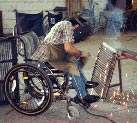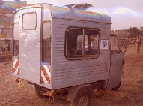This page provides an introductory tour of different access-features for passenger transport being initiated in Asia, the Americas, and Africa. The text captions in the right column describe the photos in the left column.
Photos not otherwise credited are by Access Exchange International.
Pedestrian Infrastructure |
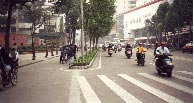 |
An accessible travel chain begins with safe streets and sidewalks. This street in Foshan, China, has separate rights-of-way for pedestrians, human-powered vehicles, and motor-powered vehicles. |
 |
Disability advisors at Rio de Janeiro’s Independent Living Center monitored access features for this street crossing, part of the Rio City Project. |
 |
Tactile guideways and tactile warning strips assist blind and sight-impaired pedestrians as well as others in Foshan, China. |
 |
Tactile warnings alert this blind person crossing a mid-street island in San Francisco, USA. |
 |
Busy intersections benefit from pedestrian controlled buttons and assist blind persons to cross through sound and vibration signals |
 |
Tactile warnings protect blind persons – and all other passengers – from getting too close to the platform edge in transit stations. |
 |
This footway adjacent to a road in Tanzania is protected by curb pieces which separate motor traffic from pedestrians and bicycles. Such basic safety measures are needed to prevent pedestrian injuries along roadways in many countries. |
 |
Even better, pedestrian and non-motorized traffic can be kept safely removed from motorized traffic by accessible sidewalks separated from the roadway, in this case by a well-designed drainage system along a main road in Tanzania. Speed bumps are used to slow traffic at crosswalks. |
 |
This pedestrian crosswalk provides level access to a bus island at an inter-modal transfer center in Mexico City.
Photo by T. Rickert, courtesy of DFID (UK) and TRL (UK).
|
Railroads and Subways |
 |
Ticket vending machines should be low enough for use by wheelchair users and all short persons, as illustrated by the good design of this machine at a BART station in the San Francisco Bay area, USA. |
 |
Stairs are often retrofitted with stair lifts in transit terminals, as here in a Tokyo subway station. However, in new construction, elevators should be considered where possible. |
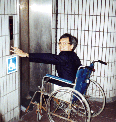 |
A wheelchair user takes the elevator from the platform level of the Shenzhen, China, railroad station. |
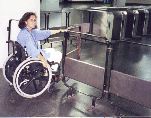 |
Wide doors are needed to accommodate wheelchair riders entering fare-paid areas of transit terminals, as in this subway station in Rio de Janeiro. |
 |
Everyone can safely board this BART train, due to a minimal horizontal and vertical gap. |
 |
However, care must be taken that horizontal gaps are not too wide. The orange “gap filler” pops up when the doors open in San Francisco’s Muni Metro, assuring a safe gap. |
 |
Small portable ramps can provide inexpensive access in many rail stations, as shown here in Tokyo. |
 |
All passengers, and especially deaf and hard-of-hearing passengers, benefit from well-located visual information, as with this route display on board a train to the Hong Kong airport. |
 |
Advocates Anjlee Agarwal (left) and Sanjeev Sachdeva board the accessible Delhi Metro on its inaugural run.
Photo courtesy of Sanjay Sakaria and Samarthya, from Amar Ujjala Indian Daily
|
Bus Transport |
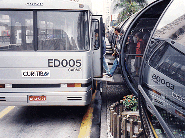 |
Express buses in Curitiba, Brazil, exemplify universal design. All passengers, including those with disabilities, quickly board with level entry. Similar Bus Rapid Transit (BRT) systems operate in Quito, Ecuador; Bogota, Colombia, and a growing number of cities around the world.
Photo by Charles Wright, Inter-American Development Bank.
|
 |
Construction of this Bus Rapid Transit (BRT) trunk line corridor in Pereira, Colombia, symbolizes the rapid spread of BRT systems around the world. BRT systems lend themselves to universal design, but details must be monitored carefully to maximize accessibility. |
 |
Although most BRT busways are on broad thoroughfares, this exclusive single-direction bus lane nearing completion in Pereira illustrates that BRT systems can sometimes be built on narrow streets.
This and above photo by T. Rickert courtesy of World Bank
|
 |
The photo shows an articulated bus docking at a Bus Rapid Transit station in León, Mexico. |
 |
Pre-paid passengers inside a station board a high-capacity BRT bus in León.
This and above photo courtesy of Sistema Integrado de Transporte Masivo de León
|
 |
A prototype low-floor bus is tested in New Delhi adjacent to a platform the same height as the bus floor. |
 |
A closeup of the same bus stop illustrates the advantages of fast boarding for all passengers from platforms that eliminate the need for climbing steps to board.
This and above photo courtesy of Gerhard Menckhoff of the World Bank.
|
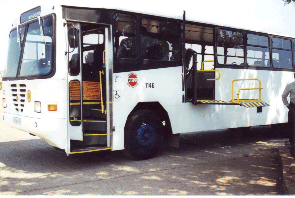 |
This prototype lift-equipped bus serves Mamelodi Township in South Africa. Note the excellent use of contrasting colors.
Photo by T. Rickert, courtesy of DFID (UK) and TRL (UK).
|
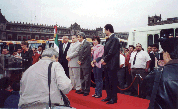 |
Mexico City officials inaugurated service in 2001 with 50 new buses equipped with lifts and other access features.
Photo courtesy of Marìa Eugenia Antunez.
|
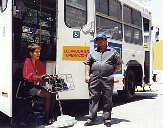 |
In addition to a wheelchair lift, this bus in Mexico City has a retractable step beneath the front entrance. |
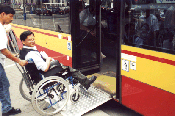 |
This low-floor bus in Warsaw, Poland, uses an inexpensive hinged ramp which provides easy boarding for passengers with disabilities. |
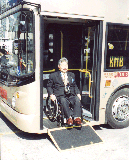 |
A low-floor bus in Hong Kong also exhibits excellent color contrast, using a bright yellow on key edges and surfaces. |
 |
This test in South Africa of a prototype platform for use at key sites shows an alternative approach to access for wheelchair users. |
 |
In this version, the bridge piece is mounted under the platform and put into place by the bus driver.
This and above photo courtesy of DFID (UK) and CSIR Transportek (South Africa).
|
 |
A prototype folding ramp is tested on this bus in San Francisco, USA. |
 |
Color-contrasted hand holds on bus doors are indispensable for all passengers and especially those with mobility concerns. |
 |
Transit systems around the world have reserved seating for seniors and passengers with disabilities, and often for pregnant women as well, as found on this TransMilenio bus in Bogotá, Colombia. |
 |
Even when bus stops are not accessible to wheelchair users, access for seniors and others with disabilities can be enhanced by a level all-weather pad even in the absence of paved sidewalks. The photo is from a TransMilenio feeder route in Bogotá.
This and above photo by T. Rickert courtesy of World Bank.
|
 |
Thousands of Mexico City’s small inaccessible microbuses are being recycled and replaced with larger vehicles, often with better access features. |
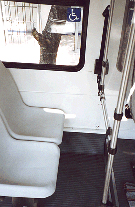 |
One such feature is this priority seating located behind the driver where there is extra leg room and it is easier for blind passengers to hear the driver call out key stops.
Photo by T. Rickert, courtesy of DFID (UK) and TRL (UK).
|
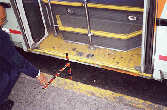 |
In other new buses in Mexico City, a wide rear door has low steps and is easily accessed by semi-ambulatory passengers from a raised sidewalk, but requires that drivers carefully pull in to the curb.
Photo by T. Rickert, courtesy of DFID (UK) and TRL (UK).
|
